The Flaming Prawn Goby (Discordipinna griessingeri) is a small and colourful fish that reaches a maximum size of about 2 inches (5 centimetres). This stunning species displays a vibrant reddish-orange body with striking dark markings. Its elongated body is complemented by a large dorsal fin and two delicate pectoral fins, creating a graceful appearance.
Natural Habitat
The Flaming Prawn Goby inhabits shallow coastal areas and coral reefs. It is commonly found in the Western Pacific Ocean. Its natural habitat consists of clear, warm waters with moderate water flow. These environments often offer a diverse array of corals, sand, and rocky structures, providing the goby with various hiding places and crevices to explore.
Keeping Flaming Prawn Goby:
The Flaming Prawn Goby is generally considered a hardy fish with a moderate care level. It can be a suitable choice for both beginner and experienced aquarists. However, proper care is still necessary to ensure its well-being. Regular monitoring of water quality parameters and maintaining stable temperature levels between 75°F and 82°F (24°C and 28°C) are essential for their health.
Special Requirements and Feeding
To thrive, the Flaming Prawn Goby requires a well-established aquarium with live sand and rock. These elements mimic its natural habitat, providing opportunities for burrowing and creating territories. It is a carnivorous species, primarily feeding on small crustaceans and zooplankton. Offering a varied diet including frozen or live brine shrimp, mysis shrimp, and high-quality marine pellets is recommended.
How Many Should I Keep?
Flaming Prawn Gobies are generally peaceful and can be kept in small groups, ideally in a species-specific aquarium. A recommended minimum tank size for a small group of these gobies is 20 gallons (75 litres). Having multiple individuals allows them to exhibit their natural social behaviours, promoting a more dynamic and engaging environment.
Lighting Preference
The Flaming Prawn Goby does not have any specific lighting requirements. It can adapt well to a range of lighting intensities, from low to moderate. Providing a mixture of subdued lighting and open areas in the aquarium mimics their natural habitat and allows them to display their vibrant colours effectively.
Suitable Tank Mates
When considering tank mates for the Flaming Prawn Goby, it is important to choose species that are compatible with its small size and peaceful nature. Suitable tank mates include other peaceful gobies, small wrasses, and certain species of clownfish. Avoid housing them with aggressive or territorial fish that may intimidate or harm the gobies.
Reproduction in the Wild
Flaming Prawn Gobies (Discordipinna griessingeri) reproduce through a fascinating process in the wild. They are protogynous hermaphrodites, meaning they begin their lives as females and can later transition into males. This reproductive strategy allows for increased flexibility and adaptability within their populations.
In the wild, Flaming Prawn Gobies form small groups or harems consisting of multiple females and a dominant male. The males, distinguished by their more vibrant colouration and elongated fins, actively court the females to initiate the breeding process. The courtship display involves intricate fin movements and colour changes that capture the attention of the females.
Once courtship is successfully established, the female releases a cluster of eggs into the water column, while the male quickly follows, releasing a cloud of sperm to fertilize the eggs externally. This external fertilization process ensures a higher chance of successful fertilization due to the dispersal of sperm throughout the water.
Breeding Discordipinna griessingeri
- Set Up:
To breed Flaming Prawn Gobies in captivity, a well-maintained and appropriately sized aquarium is required. It should have a stable temperature between 78°F and 82°F (25°C and 28°C), suitable lighting, and proper water quality parameters. The aquarium should also include live sand, rock structures, and hiding places for the gobies.
- Courtship/Spawning:
The courtship behaviour of Flaming Prawn Gobies involves intricate movements and colour changes. The male initiates the courtship display by positioning himself near the female and vibrating his fins while displaying vibrant colours. If the female is receptive, she will respond by swimming closer and displaying reciprocal colour changes. The actual spawning event occurs when the female releases her eggs and the male fertilizes them externally.
- Rearing:
After spawning, the eggs are left unattended and will hatch within a couple of days. The larvae are tiny and undergo a pelagic phase, drifting in the water column until they develop into juveniles. Providing appropriate food for the larvae, such as copepods or rotifers, is crucial for their survival and successful rearing. As they grow, the young gobies will eventually settle onto the substrate and begin to exhibit their distinct adult coloration.
Sexual Dimorphism
Sexual dimorphism in Flaming Prawn Gobies is not pronounced, as males and females share similar colouration and body shape. However, in some cases, males may develop more intense colouration and elongated fins compared to females. These differences, though subtle, can be observed in mature individuals.
Distribution
Flaming Prawn Gobies are native to the Western Pacific Ocean, specifically in areas such as Indonesia, the Philippines, and Papua New Guinea. While there are captive-bred and line-bred strains available in the aquarium trade, the original fish come from their natural habitats in these regions. Their popularity in the hobby has led to successful captive breeding programs that help reduce the pressure on wild populations.
Summary
Flaming Prawn Gobies (Discordipinna griessingeri) engage in a interesting reproductive process as protogynous hermaphrodites. Breeding them in captivity requires a well-maintained setup, courtship displays, and proper rearing techniques for the larvae. Sexual dimorphism is subtle, and these gobies are native to the Western Pacific Ocean. The availability of captive-bred strains helps support the conservation of wild populations while allowing enthusiasts to enjoy these captivating fish in their home aquariums.





Reviews
There are no reviews yet.